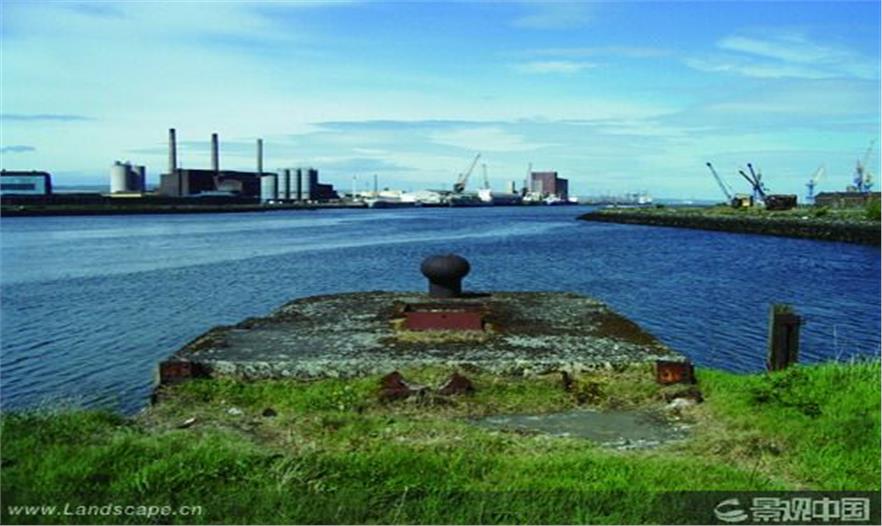后工业景观——当代有关产业遗址、场地改造和景观再生的问题与策略
1 引言
随着工厂、制造厂生产活动的结束,出现了很多被废弃的闲置土地。对很多国家、城市、政府和社区而言,改变城市环境的一种现存形式就是对产业遗址(或称棕地)的改造和振兴。这些产业遗址由于过去的工业生产的影响,现在已经破败不堪,土壤遭到污染,对周边环境造成干扰和破坏。棕地改造不仅仅限于场地外观的转变,或针对从前的产业环境进行整合,使能量耗尽、如今使用价值已经降低的土地简单恢复到高水平的生产能力,其实它标志着景观设计师在处理这种有争议的土地时,必须深刻转变方式方法。这是因为即便生产过程早已结束,棕地仍然是具有高度争议性的国土景观,这与重工业时代的副产品密切相关(如空旷的建筑,闲置的运河、铁轨、沟渠、废料场等基础设施,以及有毒的土壤和地下水)。这种改造集中在当前既成环境部分,现在城市景观设计的趋势是开放空间、“绿地”和基础设施等规划设计的规模将会大大超过废弃棕地上产业遗址改造和再利用的规模。总体而言,产业遗址是视觉上令人惊叹、但却被遗忘的景观,是被破坏、荒废、但最终可以补救的场地。在21世纪,这对任何国家而言都显得非常重要。可以说,棕地是很普遍的一类场地,它存在于任何国家和大洲,在当代政治、生态、文化、经济和美学层面上也最具争议性。
从全球角度来看,1995年²的统计数字表明:全世界325亿公顷土地中有32.2%的土地属于建成用地、被污染的废弃地、铁路、公路或者贫瘠土地。即使保守估计,假定这32.2%的土地中有1%的面积是被污染的废弃地,在世界范围内这个数字也超过了10亿公顷。但是,棕地的概念和界定在不同大洲和国家都明显不同。在美国,2002年1月³颁布的最新棕地法案认定:棕地属于不动产范畴。这些不动产由于危险品和污染物的存在或潜在威胁而难以进行扩展、振兴和再利用。在欧洲,棕地是指城市中未被完全开发的地区,无论被污染与否,从时间上可以追溯到工业革命的第一阶段,在英国是从1800—1914年,德国1870—1940年,东欧和南欧多为1900—1970年。虽然大多数早期的棕地设计都集中在欧洲和北美,但都并未制订专门针对棕地的法律。中国已经通过了《环境影响评价法》,并正在考虑修改《固体废物污染环境防治法》。这表明,虽然工业化进程和环境改造之间的关系因各个国家的地理、文化和法律体系各异而不同,但对此都存在共同利益,对这类景观场地的关注与日俱增。
2 场地
被污染的河道、化工厂、储油设施、垃圾场、钢厂、冶炼厂、废弃滨水地区、铁道区、矿山和采石场、电镀厂和纺织厂(图4),这些都属于目前需要进行景观复原、改造和设计的棕地再生型场地。这类场地和景观设计的关系如何?景观设计师又如何在这个领域卓有成效地工作?
目前,主要问题并非棕地是否需要利用和振兴,也非不论需要与否,对棕地的法律、归属权和法规框架进行评估,关键是这种产业遗址的改造工作如何进行,特别是在改造过程中棕地与景观设计的关系如何。地下水和土壤是景观设计师必须面对的最为普遍的被污染媒介。此外,在运河、池塘、湖泊和河流中也发现了大量其他污染物如污染沉淀物、地下潜水、地下储油罐、过滤液、废矿渣(图5)。最后,这些产业遗址都保留了原来的厂房和基础设施,包括钢筋、水泥和砖石构造的工厂和生产车间,有些甚至可以追溯到100年前,所有这些工业遗产皆因年久失修而遭受不同程度的损害。
如今,被废弃的产业遗址成为城市中最后一块可以建造新公园的土地。产业结构调整和棕地的改造有可能大大提升城市生活质量,因此,创造出高水准的公共空间与建造新家园和工厂车间是同样重要的事情。建立在工业废地之上的城市公园可以为各种日常聚会和文化活动提供重要的场所。
3 会议和项目
1998年,我在哈佛大学设计研究生院就后工业时代棕地问题组织了一场会展,主题是“生产场地:当前实践中有关场地技术的国际景观会展”,目的是为这类环境问题树立更高的当代视野。在这次会展上,国际上很多科学家、城市和环保专家、景观设计师(图6)针对棕地的再利用提出了很多新观点和案例分析。这些新的研究成果被编辑成册,名为《生产场地》4。在这些案例中,由彼得· 拉茨主持设计的北杜伊斯堡公园是非常值得关注的项目,这是一项面积达230公顷的原钢铁厂改造项目(图7)。
该项目位于德国鲁尔工业区北部,有毒的工业废物给规划和设计带来相当难度。为了让这个拥有250万人口的老工业区重新获得新的投资,首先需要对景观的基本生态基础进行修复。设计原理采用了再次诠释的方法,即对现存的工业构造赋予新的用途,而非单纯的破坏(图8)。
有毒物质包括某些建筑构造和废弃物既无法从场地运走,也不能忽略不管。在设计中,那些高毒性物质被密封在原先用来堆放矿石的库房中。石子被磨碎后铺在地表,形成新的土壤层和步道表层。库房顶部修建一系列屋顶花园,高低错落,富于变化。楼梯由被拆除的通道栏杆组装而成。游人经过这里可以观察到各种花卉植物的生长(图9)。
因此,随着时间的流逝,这个场地、这个公园和花园开始形成一段新的历史,而人们也会逐渐对这里产生新的认识和理解。整个改造设计融入了该地区的历史元素,利用和改造了场地在过去的工业生产中所遗留下来的各种遗迹。这种方法为景观设计提供了一种反常规的崭新视野,与传统的“绿地”场地不可等同或发生联系。对杜伊斯堡公园这类场地规划需要新的设计方法,即不但要保留场地的实体特征,还要保留场地已遭破损的自然和生态特征。这种新的设想并非要全盘清除然后再重建,而是需要在现存的废墟上找寻场地存在的合理性(图10)。
2001年,我会同生态学家罗伯特·法兰西教授在哈佛设计学院组织了第二次会展,主题为“棕地和污水的改造过程及设计实践”。这次会展是有关工业遗址改造形式和手段的各种意见的补充,探讨21世纪中这些情况各异的棕地如何焕发出新的活力。这些有代表性的棕地包括纽约斯坦顿岛FreshKills垃圾场、内华达达斯维加斯湾、伦敦湿地中心和荷兰阿姆斯特丹的Westergasfabriek公园,这里从前是被污染的煤气厂,现被改造成一个文化公园(图11)
Westergasfabriek只是值得关注的过渡性改造项目,现在国际上的注意力正集中在WESTER新区的场地改造和再利用方面,这个项目将为世界其他城市树立典范,因为在项目成型和实施的过程中有三方面的努力。首先是因为投资方、当地居民和政府官员在改造初期就对这块场地在文化、社会和民众生活方面所拥有的潜在价值有着相当的洞察力,即便它属于曾被废弃和污染的景观地带。不仅如此,这些意见和想法还能够转变成一系列清晰而明确的行动,使这块场地成为暂时的文化栖息地,并在城市的社会层面中发挥越来越重要的作用。从这方面讲,Westergasfabriek是指在棕地的原有实体结构上建立过渡性场所,这种改造思路可以帮助其他社区和城市也能重新发现那些废弃土地的价值。其次是各方对场地改造的认识不但一致,又具有创新性;同时,这种认识也可灵活变通,以满足所有投资方和当地社区的需要。在这一点上,Westergasfabriek通过各种形式的媒体和活动不断强化最初的设想,这为其他机构和国家做出示范,表明棕地的改造和再生在社会和文化意义上是非常严肃的事情。最后一个方面的努力与场地的实体特征、社会和物质属性有关,这种努力在Westergasfabriek项目上仍然继续得到强调。它在公共的开放空间用新兴、进步的设计理念将历史遗迹、结构和空间整合在一起,为其他棕地社区改造指明了方向。
Westergasfabriek煤气厂建于19世纪,位于市中心,占地12公顷。1960年停产后,已荒废了40多年。1997年,市政委员会举办了一次国际设计招标竞赛,就这块不动产的再利用征集改造方案。来自美国的景观设计师瑟琳·古斯塔福É深化了获奖方案。现在公园的整体设计包括遗址部分和邻近公园,总面积达到124公顷,既可为公共活动提供场所,又具有一定的生态功能(图11)。
东区朝向阿姆斯特丹中心,属于历史景观公园(图12)。中区表明这块土地曾经是体育和工业用地。西区则强调出与自然的和谐。公园的中轴线是整个设计的中心,是连接所有区域和建筑的走廊。项目的第一部分已于2002年春天完工。
结束语
景观设计师如何重新诠释棕地功能?是否要在特定地点保持场地本身的自然状态、工业痕迹,并增加文化功能?此外,景观设计如何把棕地塑造成与周边城市建筑的文化功能相一致的景观地区?仔细观察,会发现如果抛却那些有关自然环境和人工环境的陈腐说教,景观设计师可以在二者之间找到相似之处。这是极具挑战性的:景观设计职业应该怎样在当代的棕地环境中工作,怎样对现实中复杂机体和人工系统形成新的关注。我们有必要满足人们的怀旧情结,以明智地的态度对待这类场地。
作者简介:尼尔·科克伍德 / Niall G. Kirkwood,哈佛大学景观设计学院院长,教授。

图1

图2

图3

图4

图5

图6

图7

图8

图9

图10

图11

图12
INTRODUCTION
The productive life of factories, manufacturing plants and industrial production comes to an end, and is replaced by abandonment and dereliction. (fig.1) For many countries, cities, municipalities and communities a current form of engagement with their urban environment is concerned with the reclamation and regeneration of industrial (or brownfield) sites that by virtue of past industrial production uses, are now physically degraded, environmentally disturbed, and chemically contaminated. (fig.2) Brownfields indicate not just a change in physical appearance or a simple return to the highly productive use of exhausted and currently undervalued plots of ground- a tidying up of the past industrial environment, rather it signals a profound shift in the way in which landscape architects must lay claim to this disputed area. Disputed because it is still a highly contentious part of any national landscape, through it’s association with the by-products of heavy industrialization, (vacant buildings, the idled infrastructure of canals, rails, rivers, waste storage, and toxic soils and groundwater), long after manufacturing processes have ceased. This activity concentrates on that part of the current built environment which recent trends in current civic landscape design, open space, ’greenfield’ ¹and infrastructure planning and design have tended to overshadow- the reclamation and reuse of the industrial heritage of derelict brownfield land. Collectively they introduce visually compelling but forgotten landscapes – places of devastation, neglect, but ultimately redeemable and vital in any national vision in the 21st century. (fig.3) The class of site known as ’brownfield’ is universal. That is, it is not only found across every part of every nation and across each continent. It is also currently the most contentious- politically, ecologically, culturally, economically, and aesthetically.
If you look globally at this issue, figures from 1995 ² identify thirty two point two percent (32.2%) of the world’s 32.5 billion acres of land as considered either built-on, polluted wasteland, roads, lanes or barren land. Even if you assume very conservatively that 1% of this thirty two point two percent figure (32.2%) is polluted wasteland this amounts roughly to over 100 million acres world-wide. However brownfield definitions vary significantly between countries and across continents. In the United States the latest brownfield bill in January 2002 ³ states: ’A brownfield site is real property, the expansion, redevelopment, or reuse of which may be complicated by the presence, or potential presence of a hazardous substance, pollutant or contaminant ?" In Europe, brownfield sites are underused urban areas whether contaminated or not, dating from the first phase of industrialization. These are likely to be from 1800- 1914 in the United Kingdom, 1870- 1940 in Germany and 1900- 1970 in much of Eastern and Southern Europe. Although much of the earlier brownfield design work has been focused in Europe and North America and while it has no particular direct brownfield laws, China has strengthened its Environmental Impact Assessment legislation and is considering revisions to its Solid Waste Laws. This suggests that while the correlation between processes of industrialization and environmental transformation are specific to the geography, culture, and legal systems of nations, there exists a common emergence of interest in, and growing concern for this class of landscape site.
SITES
Polluted riverways, chemical factories and oil storage facilities, landfills and waste dumps, steel mills and smelting plants, derelict waterfronts, and railroad yards, industrial mines and quarries, printers, metal finishing factories and textile mills, (fig.4) these are the current types of brownfield regeneration sites in landscape restoration, reclamation and landscape architecture. What is the relationship of these sites to landscape architecture and design? How does the landscape designer work productively in this territory?
The main issue to be addressed is not whether brownfield sites of this type should be reclaimed or redeveloped, or the review of their legal, ownership and regulatory frameworks, however necessary that is. Rather, it is to the precise nature of how this industrial heritage work is to be physically carried out, and specifically, the relationship to landscape design in this endeavor. Groundwater and soils are the most prevalent contaminated media that landscape architects will have to address. In addition, large quantities of other contaminated material such as polluted sediments, subsurface plumes, underground storage tanks, leachate and waste slag are also found in canals, ponds, lagoons and rivers. (fig. 5) Finally there are the physical structures and infrastructure themselves onsite comprising former factories and manufacturing plants in steel, brick and concrete, some of them dating back over 100 years and all in various states of disrepair and dereliction.
Today abandoned industrial sites are simply the last available areas in the urban fabric where new parks can be created. The departure of industry and the remaining brownfield lands creates the chance to make a dramatic improvement in the living qualities of the city, and in this respect the creation of high-quality public space is just as important as the construction of new homes or workspaces. City parks on industrial brownfields can in turn become important places of encounter- as a place for daily gatherings and special cultural events.
CONFERENCES AND PROJECTS
Almost ten years ago in 1998 at the Harvard Graduate School of Design, I organized a conference and exhibition entitled Manufactured Sites: An International Landscape Conference and Exhibition on Site Technologies for Contemporary Practice on the topic of post-industrial brownfield sites that attempted to build a more contemporary vision of this aspect of the built environment. It brought together an international group of scientists, civil and environmental engineers and landscape architects (fig.6) to present new research and case studies of reclaimed brownfield sites that was documented in the ’Manufactured Sites’ publication 4. Of the examples presented the metamorphosis of a former steel works into the 230 hectare Landscape Park Duisburg North by landscape architect Peter Latz stood as an exemplary model. (fig.7)
The project is located in the northern Ruhr area of Germany where toxic waste has set the parameters for site planning and design. To make this area with 2.5 million inhabitants attractive again for new investment, the fundamental ecological base of the landscape was restored. The working method over the site was one of adaptation and reinterpretation, a metamorphosis of industrial structures without destroying them. (fig.8)
The toxic material including existing structures, walls and waste could neither be taken away from the site, nor could it be ignored. The design placed highly toxic material in sealed bunkers that were earlier used to store iron ore. Stones were ground down to become new soil and walking surfaces. A series of roof gardens were built on the bunkers and sown with flowering plants. Staircases were developed from dismantled walkways. Passing over these zones pedestrians can watch the slowly growing gardens, built at various heights and depths within the bunker site. (fig.9)
So bit by bit, another history, another understanding of the contemporary site and this park and garden is developing. The plan integrated the historical dimensions of the area and worked with the by-products of the earlier activities on the site. It suggests a new point of departure in landscape architecture that cannot be equated or associated with traditional ’greenfield’ sites. The task of dealing with contemporary sites such as Duisburg requires new design methods that accept the site’s physical qualities, as well as their destroyed nature and topography. This new vision is not based on a total ’clearing and re-cultivation’rather it seeks its justification within the existing demolished and exhausted forms. (fig.10)
Iorganized three years later in 2001 jointly with ecologist Professor Robert France a second landscape conference and exhibition event at the Harvard Design School titled Brown Fields Gray Waters- Reclamation Processes and Design Practices. This conference and exhibition was an affiliation of different attitudes to what these landscapes might become and how they may be formed and remade in the twenty-first century around such public and varied brownfield sites as the FreshKills Landfill, Staten Island, New York, the Las Vegas Wash, Nevada, the London Wetlands Center, and the Westergasfabriek lands in Amsterdam, Holland- a former polluted gasworks turned park and cultural center. (fig.11)
The former Westergasfabriek site and the cultural programming stands as an exemplary interim project and intense international attention is now focused on the New Westerpark site reclamation and reoccupation as a model for efforts in other urban centers around the world. This recognition is perhaps best explained through three areas of endeavor over the life of this project so far. The first can be directed to the initial perceptions by a variety of stakeholders, residents and city officials of the enormous ongoing cultural, social and civic value of the Westergasfabriek site as a landscape even in it’s former abandoned and polluted state. Not only perceptions but the transformation of these opinions and thoughts into a series of clear and directed actions about the interim cultural inhabitation of the landscape and the increasing visibility of the site in the urban social fabric. In this Westergasfabriek points to the temporary inhabitation in the physical structure of a brownfield site as a working method for other communities and cities to recapture the values of their lost or vacant lands. The second is in the development of a consistent and creative vision for the site that at the same time is robust yet flexible over time and embraces all stakeholders and local communities. In this regard, Westergasfabriek through the consistent reinforcement of the initial vision in all forms of media and activities demonstrates for other agencies and countries the seriousness of the act of brownfield reclamation as a social and cultural endeavor. Finally the areas of endeavor associated with the physical, social and material qualities of the site continue to be underscored on the Westergasfabriek project. The project by folding historic surfaces, structures and places with emerging and progressive ideas in public open space, gives direction to other brownfield communities.
Abandoned in 1960, the nineteenth century inner city 12-acre gasworks site remained desolate for almost four decades. In 1997 the Council held an international design competition in an effort to solicit ideas for the future reuse of the property. American landscape architect Kathryn Gustafson based in Seattle, USA and London, England developed the winning design. The park design now including the industrial grounds with the adjacent park design for a total of 124 acres provides for both city and nature. (fig.11)
The eastern side, towards the center of Amsterdam, is reminiscent of a historical city park; (fig.12) the central area mirrors the use of the landscape as a site for sport and industry; the western side emphasizes harmony with nature¡ (fig.13) The central axis of the park forms the backbone of the plan and is the corridor connecting all areas and buildings. The first part of the project was completed in Spring 2002.
ENDING
How can landscape architects re-interpret the chronology of a brownfield site, be it natural, industrial or cultural in its disposition, in a specific geographic location and secondly how can design shape this site into a landscape consonant with the cultural artifice of the surrounding urban fabric. By looking observantly, without trite moralizing at the natural world as well as the built and disposable world, the landscape architect builds at the great overlap between the two. This suggests a challenging new paradigm for how the landscape profession ought to work within our contemporary brownfield environment, a new quality of attention to the intricate organic and artificial systems of reality. Looking beyond nostalgia for the impossibly pristine, and clear-sighted beyond disgust for the actual present site conditions.









